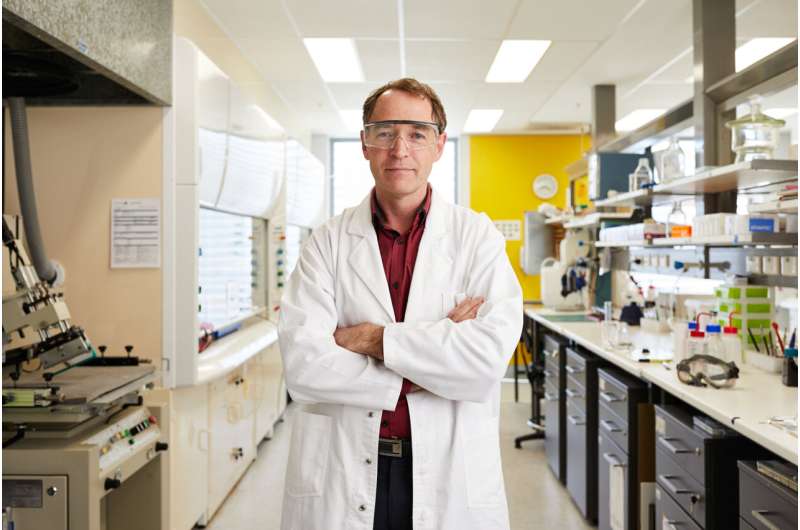Scientists develop new type of artificial muscle inspired by DNA supercoiling

University of Wollongong (UOW) researchers have mimicked the supercoiling properties of DNA to develop a new type of artificial muscle for use in miniature robot applications. Their research is published today in Science Robotics.
One of the challenges to the miniaturization of robotics technology, such as developing micro-tools for remote robotic surgery, is that conventional mechanical drive systems (or “actuators”) are difficult to downsize without loss of performance. Artificial muscles that generate large and reversible movement, high mechanical work output, respond quickly and last for millions of cycles would be ideally suited for miniature machines, said the study’s lead author, Professor Geoffrey Spinks from UOW’s Australian Institute for Innovative Materials.
“The miniaturization of robotic devices will have many applications, but the main challenge is how to generate powerful movement and forces in tiny devices,” Professor Spinks said.
“Electric motors are simply too complicated to downsize, so we look to artificial muscles to provide compact mechanical actuation.
“Arrays of miniature artificial muscles could be combined to fabricate advanced prosthetics and wearable devices to help people move when they have a physical disability or injury. Tiny actuators can also be incorporated into tools for non-invasive surgery and micro-manipulators in industry.”
The inspiration for this new type of artificial muscle came from nature. To pack into the cell nucleus, DNA must contract by more than 1000 times, in part via a process called supercoiling.
“Our work describes a new type of artificial muscle that mimics the way that DNA molecules collapse when packing into the cell nucleus,” Professor Spinks said.
“We were able to create DNA-like unwinding by swelling twisted fibers. Supercoiling occurred when the fiber ends were blocked against rotation. We show that these new artificial muscles generate a large amount of mechanical work.”
The research team optimized the fibers through modeling to maximize stroke and work output, and downsized the fibers to decrease their response time. They then successfully trialed the new muscles on possible applications, including micro-scissors and micro-tweezers.
Co-author Dr. Sina Naficy, now at the University of Sydney, said, “Seeing what happens in the natural world and being able to mimic those actions in a synthetic system is very interesting. We have learned that forming fiber composites where the fiber is wound into a helix provides a convenient way to store and release mechanical energy. There are many examples of these kinds of helical composites in nature, from DNA molecules to plant tendrils. These systems offer exciting prospects for future developments.”
The action of the new muscles is quite slow, limiting their application at present, so the next challenge is to speed up the response, according to Dr. Javad Foroughi from UOW’s Faculty of Engineering and Information Sciences, another co-author of the research paper. “We have used hydrogels to generate the volume changes that drive the supercoiling but that response is inherently slow,” Dr. Foroughi said.
“We do believe that the speed can be increased by making smaller diameter fibers, but right now, the applications are limited to those that need a slower response,” Professor Spinks said. “Developing faster supercoiling muscles would open up further applications. We hope that others will explore different means for generating a volume change—such as by electrical heating—that can lead to a faster response.”
Mechanical engineers develop new high-performance artificial muscle technology
G.M. Spinks el al., “Dual high-stroke and high–work capacity artificial muscles inspired by DNA supercoiling,” Science Robotics (2021).
robotics.sciencemag.org/lookup … /scirobotics.abf4788
Citation:
Scientists develop new type of artificial muscle inspired by DNA supercoiling (2021, April 28)
retrieved 8 May 2021
from https://techxplore.com/news/2021-04-scientists-artificial-muscle-dna-supercoiling.html
This document is subject to copyright. Apart from any fair dealing for the purpose of private study or research, no
part may be reproduced without the written permission. The content is provided for information purposes only.
Stay connected with us on social media platform for instant update click here to join our Twitter, & Facebook
We are now on Telegram. Click here to join our channel (@TechiUpdate) and stay updated with the latest Technology headlines.
For all the latest Technology News Click Here
For the latest news and updates, follow us on Google News.